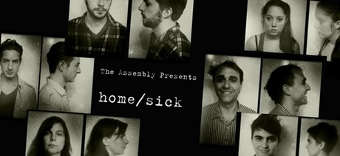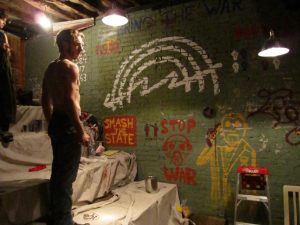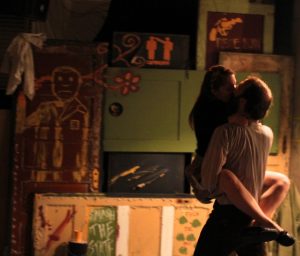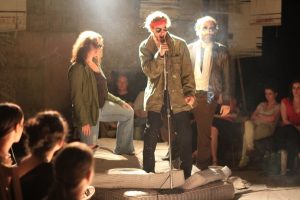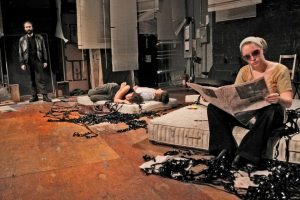GOING UNDERGROUND
A Critics’ Pick by both The New York Times and Backstage, the passionate docudrama Home/Sick explores how idealism turns to radicalism, as a handful of leaders from the ’60s-era Students for a Democratic Society take over the once-peaceful protest organization and turn it into the ’70s-era radical group known as the Weather Underground, the revolutionary force that once sought to overthrow the U.S. government.
Devised, researched and collectively written by New York’s The Assembly theater ensemble, Home/Sick comes to L.A. as a co-production with the Odyssey Theatre beginning June 9 and playing through July 3, 2016.
Here is some fascinating history behind this theatrical reimagining of the history of the Weather Underground, and some thoughts from The Assembly theater ensemble.
In 1962, Students for a Democratic Society (SDS), a fledgling student activist group, published “The Port Huron Statement,” a political manifesto calling for participatory democracy and non-violent civil disobedience. The manifesto’s rejection of Cold War rhetoric was radical at the time, became a seminal document of the New Left and pushed SDS to the forefront of the progressive movement.
With the momentum created by the Civil Rights Movement and the escalation of the war in Vietnam, SDS grew in popularity. Beginning with 9 chapters and approximately 300 members at the beginning of the decade, by 1968, SDS had over 300 autonomous college chapters and 100,000 active members. For most of the 1960s, SDS was among the largest and most visible activist groups in the nation. The events of 1968–the Tet Offensive, the assassinations of Martin Luther King Jr. and Robert Kennedy, the student occupation of Columbia University, the police brutality on display against protesters at the Democratic National Convention–further radicalized the student movement.
LBJ’s escalation of the war in Vietnam had alienated hundreds of thousands of college students from the Democratic Party, and by late 1968, SDS’s rhetoric had taken on definitive Marxist overtones. The organization began to fragment along ideological lines that mirrored larger tensions among the differing embodiment of Marxism in the USSR, China, Cuba and across the third-world. The turning moment for SDS came at its June 1969 National Convention. After an internal debate about tactics and political objectives split the participants, a militant faction of SDS leaders seized control of the National Office. Amid the pandemonium, the new leadership (who called themselves The Weathermen after the Bob Dylan lyric, “you don’t need a weatherman to know which way the wind blows”) called for a riot in Chicago to coincide with the trial of the Chicago 8, a group of protesters indicted for conspiracy for the demonstrations at the Democratic convention the previous summer.) This riot, dubbed “Days of Rage” by the press, alienated most of the SDS chapters who rejected the call for action en masse. By all accounts, Days of Rage was a political and organizational failure.
By 1970, SDS had ceased to exist. The Weathermen, despite having lost almost their entire base, were undeterred. Now a small committed cadre believing themselves to be allied with the Black Panthers and the Vietcong, the Weathermen (who were, almost to a person, white middle-class students) declared war against the imperialist and corrupt American government. The accidental deaths of 3 Weathermen when a bomb they were constructing prematurely detonated, and increasing scrutiny from the FBI, forced the Weathermen to go underground later in 1970 and rethink their tactics.
Now calling themselves the Weather Underground, the group pursued a campaign of symbolic bombings of government buildings and other symbols of American imperialism. They successfully bombed over 25 buildings, including the Pentagon and the Capital Building. No people were killed in any of their acts of property destruction. The Weathermen spent much of the next 3 years on the FBI’s Most-Wanted List, but most charges against them were eventually dropped after it was revealed that the FBI had performed illegal and unconstitutional “black bag jobs” in its pursuit of the Weathermen. By 1976, the organization had dissolved amid yet more ideological divisions and general fatigue with the underground lifestyle.
The arrogant, aggressive and short-sighted administration of George W. Bush radicalized many of us—as it did many young Americans. It darkened the way we thought and felt about our country, and we often felt powerless to do anything about it. Eight years later, when Barack Obama achieved a landmark victory, meaningful change at last seemed imminent. A few years into the new administration, we weren’t so sure. Under Bush and Cheney, we’d thought that things could not get any worse; under Obama, we began to fear they couldn’t get any better. Occupy Wall Street was still over a year away.
And then we started learning about the Weather Underground, a story which might as well have come from another planet, let alone another time. Their advocacy of violence horrified us, but we were inspired by their analysis of American society, and their willingness to risk their lives to change it. Regardless of their dangerous and questionable means, the very existence of an organization dedicated to changing the world as they knew it, that had believed not only that the whole system was wrong, but that it was possible to shatter it and replace it with something new: that felt remarkable.
The process of creating HOME/SICK began with extensive research into memoirs, histories, and documentary films chronicling the rise and fall of The Weathermen, as well as literature inspired by the movement. Months of improvisation, collective writing, and theatrical experimentation followed, leading to a breadth of material devised by the cast and creative team. Each member of the ensemble created a character based partially on an actual member (or members) of the Weather Underground, and partly on the actor’s own identity: his or her ambitions, anxieties and relationship to the rest of the group. After ten months of workshopping and rehearsing, the material was condensed and shaped into the arc of the revolutionary collective’s struggle, successes and failures to transform American politics and society. The final production incorporates live music, contact improv, audience participation, autobiographical material, a fully improvised scene, and the live creation of visual art—all in a tautly structured story carefully calibrated for maximum impact.
photos of New York production by Nick Benacerraf courtesy of The Assembly
Home/Sick
The Assembly
Odyssey Theatre Ensemble
2055 S. Sepulveda Blvd in West L.A.
June 9 – July 3, 2016
for tickets, call 310.477.2055 x 2 or visit Odyssey Theatre
